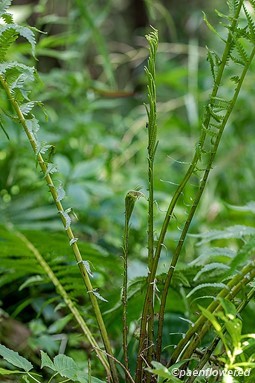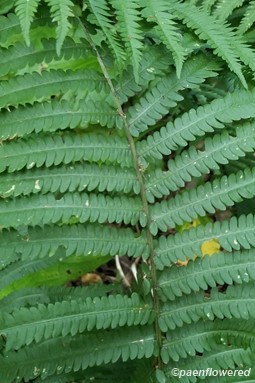Matteuccia struthiopteris
One of the largest ferns, with ostrich-plume like fronds
Matteuccia struthiopteris ostrich fern
The tall, erect, gracefully arching sterile fronds have long, thin, closely-spaced pinnae tapering elegantly at the end. The spores located on shorter, narrower fertile fronds become woody and brown, and are released throughout the winter. Sterile fronds wither with the first frost, but stiff, dark brown fertile fronds remain through the winter. The fiddleheads are edible and often harvested.
Habitat & Range
Rich woods, stream banks, floodplains, swamps, and places with wet or damp soils.
Range is Maine to Virginia, most abundant in the northern areas.
Wetland code: FAC
Phenology
Spores are ripened in late autumn and persist through the winter. The spores are released either end of winter or early the following spring depending on the wind conditions. Fertile fronds emerge mid to late summer and overwinter.
Characteristics
Sterile blade oblong, widest at the top, with rapidly pointed tip, gradually tapering toward the base. Cut into 20 to 60 pairs of pinnae. Not evergreen.
Fertile blade narrow, stiff, green at first, dark brown later. Shaped like a canoe paddle, cut into pinnae. Emerges mid to late summer.
Sterile pinnae long, narrow, pointed, alternate, slightly ascending in upper portion Deeply cut into 20-40 pairs of lobes; veins not forked, extending to margin. Lower pinnae much smaller, and sometimes clasping the rachis.
Fertile pinnae contracted, curling around the sori forming hard peapods about 2 in long and 1/3 in thick
Rachis green, stout. Sterile rachis with whitish hairs.
Stipe much shorter than blade; rigid, stout, dark brown, deeply grooved at base with rounded back. Stipe of fertile frond is dark, stiff, erect, about the same length as fertile blae.
Rhizome stout, with erect, emerging symmetrical crown. Spreads by numerous underground long, slender runners.
Sori on margins, hidden in rolled edge of peapod-like pinnae.
Plant Codes
S-rank: No rank
G-rank: G5 (Secure)












Comments
Have you spotted this plant in your area? We'd love to hear about your experience! Share your comments or questions about the plant below. Comments are moderated before posting.